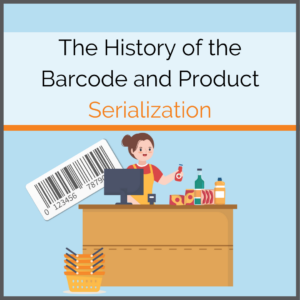
Barcodes and serialization are ubiquitous in our daily lives, yet many of us rarely think about their origins and significance. From grocery stores to pharmacies, these technologies play a crucial role in ensuring efficiency, accuracy, and safety. But what is the history of the barcode?
Just over fifty years ago, the shopping process was quite different. Cashiers manually entered the price of each item into a cash register—a process prone to errors and inefficiency. Fast forward to today: a simple scan of a barcode instantly retrieves all necessary information. A process so ingrained in our culture that anyone can perform it at a self-checkout. This transformation didn’t happen overnight and involved a series of innovations and breakthroughs.
The Birth of the Barcode
The history of the barcode’s invention is as fascinating as it is unexpected. It’s 1948, and Bernard Silver hears the woes of a supermarket operator looking for a solution to automatically check out products at the register. Silver approached Norman Woodland, a mechanical engineer, with this idea and persuaded him to look for a solution. According to Woodland, the spark of inspiration came to him at the beach, where he drew a series of lines in the sand, inspired by Morse code. Building on this, he envisioned a system that could encode information in a similar way. This moment marked the beginning of the barcode.
Despite numerous challenges, from technical difficulties to skepticism from potential investors, Woodland and Silver continued to develop the concept. In 1952, they finally received a patent for their invention. Despite this milestone, barcodes were not commercially used until the 1970s. The first commercial use of barcodes occurred in 1974 at a Marsh supermarket in Troy, Ohio. A pack of Wrigley’s gum was the first product scanned with a barcode, marking a significant moment in retail history. This innovation revolutionized the way stores managed their inventory and paved the way for the worldwide adoption of barcodes.
How Do Barcodes Work?
Barcodes may appear as simple black and white lines, but there’s fascinating science behind them. At their core, barcodes are a method of encoding information in a visual pattern that can be read by machines. The typical barcode consists of a series of parallel lines and spaces of varying widths. These patterns represent numbers and letters that can be decoded by a barcode scanner.
When a barcode scanner reads a barcode, it emits a beam of light that is reflected by the barcode and sent back to the scanner. The scanner converts the reflected light into electrical signals, which are processed to retrieve the encoded information. This process happens in a fraction of a second, allowing for quick and accurate data retrieval.
The technology behind barcodes has evolved significantly over the years. The first barcodes were simple and could only store a limited amount of information. Modern barcodes, like QR codes, can store much more data and can be read by smartphones and other devices. This development has expanded the applications of barcodes beyond retail, making them a versatile tool across industries.
From Prototype to Supermarket
The introduction of barcodes revolutionized inventory management for supermarkets. With a simple scan, cashiers could instantly retrieve product information, reduce errors, and speed up the checkout process. This innovation also enabled more accurate tracking of inventory, allowing retailers to better manage stock and reduce waste. The impact of barcodes on retail was profound. They not only improved efficiency but also paved the way for the development of more advanced technologies like QR codes and RFID tags.
What Does Serialization Have to Do with Barcodes?
Serialization also utilizes these technologies. It is a crucial concept in modern manufacturing and supply chain management. At its core, serialization involves assigning a unique identifier to a product, enabling precise tracking and traceability throughout its lifecycle. This process is essential for ensuring the authenticity and safety of products, especially in industries where counterfeiting and quality control are significant concerns.
Serialization in the Pharmaceutical Industry
Serialization plays a critical role in the pharmaceutical industry, where ensuring the safety and authenticity of medications is of utmost importance. With the rise of counterfeit drugs, serialization has become an indispensable tool in combating this global problem. By assigning a unique identifier to each medication package, serialization enables precise tracking along the entire supply chain.
In the pharmaceutical industry, serialization involves assigning a unique serial number to each medication package. This identifier is recorded in a central database, allowing real-time tracking from the manufacturer to the pharmacy. Thanks to these levels of traceability, it is possible to keep counterfeit drugs out of the supply chain and ensure that patients receive safe and effective medications.
Serialization also improves the ability to conduct recalls efficiently. In the event of a defect or contamination, manufacturers can quickly identify and recall affected products, minimizing risk to patients. All of this is made possible by the invention of the barcode by Norman Woodland and Bernard Silver. These capabilities are crucial for maintaining public trust and ensuring the safety of the pharmaceutical supply chain. Thus, the invention of the barcode not only revolutionized retail but also plays an essential role in ensuring people’s safety today.
Are you looking for a provider for pharmaceutical serialization or dissatisfied with your current provider? Feel free to contact us directly and schedule a non-binding appointment.